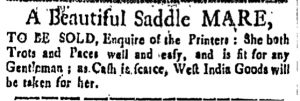What was advertised in a colonial American newspaper 250 years ago this week?

“The Particular Day for Sale will be made known by Advertisements being put up at the Merchant’s Coffee-House.”
An announcement about an upcoming auction of “ONE of the best half Blood Horses in America” began running in the New-York Journal in October 1772. The advertisement provided a variety of details about the horse, stating that it was “4 Years old, and upwards of 15 Hands high.” In addition, the horse was “an exceeding fine bay, trots well, and is warranted sound, [and] he is sufficiently broke, both for Saddle and Carriage.” The notice also proclaimed that the horse “was got by Capt. De Laney’s famous Horse Wildair, out of one of the best Esopus Breeding Mares, whose Size, Strength and Courage are equal to any in the Country.”
The advertisement gave a location for the auction, the Merchant’s Coffee House, and even a time, “12 o’Clock,” but not a day. Instead, it indicated that the auction would take place either “the latter End of this or the beginning of next Month.” A nota bene explained why a date had not yet been set. The horse had not yet been “brought down” to the city. It also specified that the “Particular Day for Sale will be made known by Advertisements being put up at the Merchant’s Coffee-House.” The notice in the newspaper encouraged interested parties to visit a local business to look for other advertisements with more information posted there. Those additional advertisements may have been broadsides produced in the printing office of the New-York Journal or may have been handwritten notices. Either way, the newspaper notice testified to a broader scope of advertising that colonizers encountered as they conducted business and went about their daily lives.
The newspaper advertisement also included a notation intended solely for the compositor and others working in the printing office: “54—.” That number referred to the issue in which the notice first appeared, “NUMB. 1554” on October 15. Many other advertisements included a second number that corresponded to the final issue in which they should appear, alerting the compositor when to discontinue them. The dash in this advertisement indicated that it should run indefinitely until the advertiser requested its removal, a decision that made sense considered that a date for the auction had not been set. It ended up running for four consecutive weeks, from October 15 through November 5, costing five shilling according to the rates published in the colophon of the New-York Journal. By then, the advertiser posted some sort of notice at the Merchant’s Coffee House, at least according to the pledge made in the newspaper notice.





